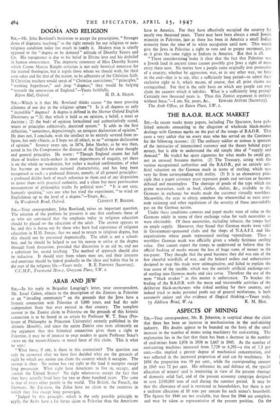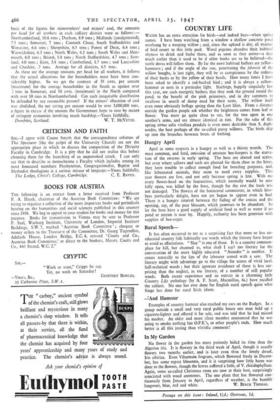ASPECTS OF MINING
Snt,—Your correspondent, Mr. B. Johnston, is sceptical about the claim that there has been an increase in mechanisation in the coal-mining industry. His doubts appear to be founded on the basis of the small increase in the number of mines using machinery for coal-cutting. The explanation lies in the fact that there has been a decrease in the number of coal-mines from 1,976 in 1938 to 1,667 in 1945. As the number of coal-cutting machines increased from 7,729 to 8,292—a rise of 7.3 per cent.—this implied a greater degree of mechanical concentration, and was reflected in the increased proportion of coal cut by machinery. In 1938 the proportion was 59 per cent., while the corresponding amount in 1945 was 72 per cent. His reference to, and defence of, the special allocation of miners' coal is interesting in view of the present shortage of domestic solid fuel, and of the present economy campaign designed to save 2,500,000 tons of coal during the summer period. It may be that the allowance oficoal is restricted to householders, but there is not a uniform allocation of 10 tons per annum for each miner's household. The figures for 1946 are not available, but those for 1944 are complete, and may be taken as representative of the present position. On the
basis of the figures for mineworkers' and miners' coal, the amounts per head for all workers in each colliery district were as follows:— Northumberland, 10.6 tons ; Durham, 8.9 tons ; Midlands (amalgamated), 7.5 tons ; Somerset, 7 tons ; Cannock Chase, South Staffordshire and Worcester, 6.6 tons ; Shropshire, 6.5 tons ; Forest of Dean, 6.4 tons ; Warwickshire, 6.3 tons ; North Wales, 6.2 tons ; South Wales and Mon- mouth, 6.0 tons ; Bristol, 5.8 tons ; North Staffordshire, 4.7 tons ; Scot- land, 4.0 tons ; Kent, 3.8 tons ; Cumberland, 1.7 tons ; and Lancashire and Cheshire, .7 tons. Average for all districts, 6.5 tons. As these are the average amounts per head for all workers, it follows that the actual allocations for the householders must have been con- siderably higher. So we get the contrast of 35 cwts. per annum (maximum) for the average householder in the South as against over tons in Somerset, and 50 cwts. (maximum) in the North compared with over 10 tons in Northumberland. Can such inequitable distribution be defended by any reasonable person? If the miners' allocation of coal was abolished, the net saving per annum would be over 3,000,000 tons, a figure in excess of the amount the Government hope to save by mean of stringent economies involving much hardship.—Yours faithfully,



































 Previous page
Previous page